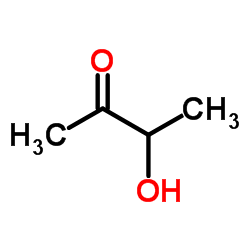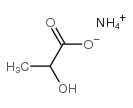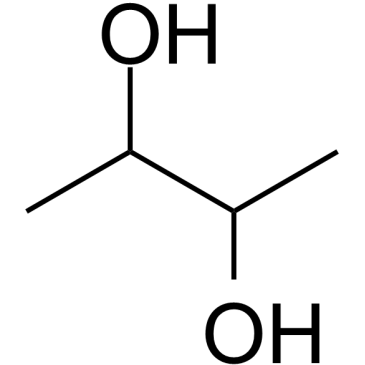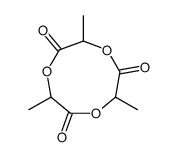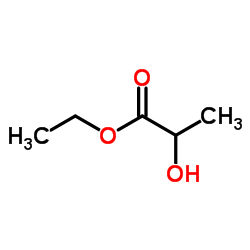814-80-2
| 中文名 | 乳酸钙 |
|---|---|
| 英文名 | Calcium Lactate |
| 中文别名 | Α-羟基-丙酸钙五水化合物 |
| 英文别名 |
Calcium dilactate
EINECS 212-406-7 MFCD00150986 Propanoic acid, 2-hydroxy-, calcium salt (2:1) Calcium bis(2-hydroxypropanoate) Calcium lactate |
| 描述 | 乳酸钙被饮料行业用作强化果汁的钙源。乳酸钙促进豆芽的生长和植酸降解[1][2]。 |
|---|---|
| 相关类别 | |
| 参考文献 |
| 沸点 | 227.6ºC at 760 mmHg |
|---|---|
| 分子式 | C6H10CaO6 |
| 分子量 | 218.218 |
| 闪点 | 109.9ºC |
| 精确质量 | 218.010330 |
| PSA | 120.72000 |
| 外观性状 | 白色粉末 |
| 储存条件 | 保持容器密封,储存在阴凉,干燥的地方 |
| 稳定性 | 常温常压下稳定,避免氧化物接触 外观为白色的颗粒或粉末。几乎无臭,基本无味,在水中缓慢溶解成透明或微浑浊的溶液。易溶于热水,几乎不溶于乙醇、乙醚及氯仿,在空气中稍风化,加热到150℃则成无水物。 |
| 计算化学 | 1、 氢键供体数量:2 2、 氢键受体数量:6 3、 可旋转化学键数量:0 4、 拓扑分子极性表面积(TPSA):121 5、 重原子数量:13 6、 表面电荷:0 7、 复杂度:53.5 8、 同位素原子数量:0 9、 确定原子立构中心数量:0 10、 不确定原子立构中心数量:2 11、 确定化学键立构中心数量:0 12、 不确定化学键立构中心数量:0 13、 共价键单元数量:3 |
| 更多 | 1. 性状:白色至乳白色结晶或粉末,基本无臭无味。 2. 密度(g/mL,25/4℃):未确定 3. 相对蒸汽密度(g/mL,空气=1):未确定 4. 熔点(ºC):未确定 5. 沸点(ºC,常压):未确定 6. 沸点(ºC,5.2kPa):未确定 7. 折射率:未确定 8. 闪点(ºC):未确定 9. 比旋光度(º):未确定 10. 自燃点或引燃温度(ºC):未确定 11. 蒸气压(kPa,25ºC):未确定 12. 饱和蒸气压(kPa,60ºC):未确定 13. 燃烧热(KJ/mol):未确定 14. 临界温度(ºC):未确定 15. 临界压力(KPa):未确定 16. 油水(辛醇/水)分配系数的对数值:未确定 17. 爆炸上限(%,V/V):未确定 18. 爆炸下限(%,V/V):未确定 19. 溶解性:易溶于热水成透明或微混浊的溶液,不溶于乙醇、氯仿和乙醚。 |
Synonym:Lactic acid, calcium salt; calphosan; conclyte calcium; 2-hydroxypropanoc acid, calcium salt Section 2 - COMPOSITION, INFORMATION ON INGREDIENTS
Risk Phrases: None Listed. Section 3 - HAZARDS IDENTIFICATION EMERGENCY OVERVIEW
Not available. Potential Health Effects Eye: May cause eye irritation. Skin: May cause skin irritation. Ingestion: Ingestion of large amounts may cause gastrointestinal irritation. Inhalation: May cause respiratory tract irritation. Chronic: No information found. Section 4 - FIRST AID MEASURES Eyes: Immediately flush eyes with plenty of water for at least 15 minutes, occasionally lifting the upper and lower eyelids. Get medical aid. Skin: Flush skin with plenty of water for at least 15 minutes while removing contaminated clothing and shoes. Get medical aid if irritation develops or persists. Ingestion: If victim is conscious and alert, give 2-4 cupfuls of milk or water. Never give anything by mouth to an unconscious person. Get medical aid. Inhalation: Remove from exposure and move to fresh air immediately. If not breathing, give artificial respiration. If breathing is difficult, give oxygen. Get medical aid if cough or other symptoms appear. Notes to Physician: Section 5 - FIRE FIGHTING MEASURES General Information: As in any fire, wear a self-contained breathing apparatus in pressure-demand, MSHA/NIOSH (approved or equivalent), and full protective gear. During a fire, irritating and highly toxic gases may be generated by thermal decomposition or combustion. Extinguishing Media: In case of fire, use water, dry chemical, chemical foam, or alcohol-resistant foam. Section 6 - ACCIDENTAL RELEASE MEASURES General Information: Use proper personal protective equipment as indicated in Section 8. Spills/Leaks: Clean up spills immediately, observing precautions in the Protective Equipment section. Sweep up, then place into a suitable container for disposal. Section 7 - HANDLING and STORAGE Handling: Wash thoroughly after handling. Wash hands before eating. Use with adequate ventilation. Avoid contact with skin and eyes. Avoid ingestion and inhalation. Storage: Store in a cool, dry place. Keep container closed when not in use. Section 8 - EXPOSURE CONTROLS, PERSONAL PROTECTION Engineering Controls: Use adequate ventilation to keep airborne concentrations low. Exposure Limits CAS# 814-80-2: Personal Protective Equipment Eyes: Wear appropriate protective eyeglasses or chemical safety goggles as described by OSHA's eye and face protection regulations in 29 CFR 1910.133 or European Standard EN166. Skin: Wear appropriate protective gloves to prevent skin exposure. Clothing: Wear appropriate protective clothing to minimize contact with skin. Respirators: Follow the OSHA respirator regulations found in 29 CFR 1910.134 or European Standard EN 149. Use a NIOSH/MSHA or European Standard EN 149 approved respirator if exposure limits are exceeded or if irritation or other symptoms are experienced. Section 9 - PHYSICAL AND CHEMICAL PROPERTIES Physical State: Solid Color: white Odor: None reported. pH: Not available. Vapor Pressure: Not available. Viscosity: Not available. Boiling Point: Not available. Freezing/Melting Point: Not available. Autoignition Temperature: Not applicable. Flash Point: Not applicable. Explosion Limits, lower: Not available. Explosion Limits, upper: Not available. Decomposition Temperature: Not available. Solubility in water: Soluble in water. Specific Gravity/Density: Not available. Molecular Formula: C6H10O6Ca.5H2O Molecular Weight: 308.2134 Section 10 - STABILITY AND REACTIVITY Chemical Stability: Stable under normal temperatures and pressures. Conditions to Avoid: Incompatible materials. Incompatibilities with Other Materials: Strong oxidants. Hazardous Decomposition Products: Carbon monoxide, irritating and toxic fumes and gases, carbon dioxide, calcium oxide. Hazardous Polymerization: Has not been reported. Section 11 - TOXICOLOGICAL INFORMATION RTECS#: CAS# 814-80-2: OD4150000 LD50/LC50: Not available. Carcinogenicity: Calcium Lactate - Not listed by ACGIH, IARC, or NTP. Other: See actual entry in RTECS for complete information. Section 12 - ECOLOGICAL INFORMATION Section 13 - DISPOSAL CONSIDERATIONS Products which are considered hazardous for supply are classified as Special Waste and the disposal of such chemicals is covered by regulations which may vary according to location. Contact a specialist disposal company or the local waste regulator for advice. Empty containers must be decontaminated before returning for recycling. Section 14 - TRANSPORT INFORMATION IATA Not regulated as a hazardous material. IMO Not regulated as a hazardous material. RID/ADR Not regulated as a hazardous material. Section 15 - REGULATORY INFORMATION European/International Regulations European Labeling in Accordance with EC Directives Hazard Symbols: Not available. Risk Phrases: Safety Phrases: WGK (Water Danger/Protection) CAS# 814-80-2: No information available. Canada CAS# 814-80-2 is listed on Canada's DSL List. CAS# 814-80-2 is not listed on Canada's Ingredient Disclosure List. US FEDERAL TSCA CAS# 814-80-2 is listed on the TSCA inventory. SECTION 16 - ADDITIONAL INFORMATION N/A |
|
毒理学数据: 急性毒性:小鼠静脉LD50:140mg/kg 生态学数据: 对水是稍微有害的,不要让未稀释或大量的产品接触地下水,水道或者污水系统,若无政府许可,勿将材料排入周围环境 CHEMICAL IDENTIFICATION
HEALTH HAZARD DATAACUTE TOXICITY DATA
|
| 风险声明 (欧洲) | 36/37/38 |
|---|---|
| 安全声明 (欧洲) | S26-S36/37/39 |
| 海关编码 | 2918110000 |
|
~% 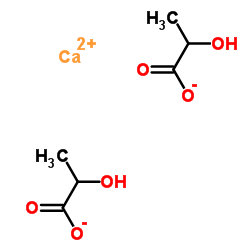
814-80-2 |
| 文献:EP839459 B1, ; |
|
~% 
814-80-2 |
| 文献:WO2010/4501 A2, ; Page/Page column 56 - 58 ; |
| 上游产品 2 | |
|---|---|
| 下游产品 10 | |
| 海关编码 | 2918110000 |
|---|---|
| 中文概述 | 2918110000. 乳酸及其盐和酯. 增值税率:17.0%. 退税率:13.0%. 监管条件:AB(入境货物通关单,出境货物通关单). 最惠国关税:6.5%. 普通关税:30.0% |
| 申报要素 | 品名, 成分含量, 用途 |
| 监管条件 | A.入境货物通关单 B.出境货物通关单 |
| 检验检疫 | R.进口食品卫生监督检验 S.出口食品卫生监督检验 M.进口商品检验 N.出口商品检验 |
| Summary | 2918110000. lactic acid, its salts and esters. VAT:17.0%. Tax rebate rate:13.0%. Supervision conditions:AB(certificate of inspection for goods inward,certificate of inspection for goods outward). MFN tariff:6.5%. General tariff:30.0% |




